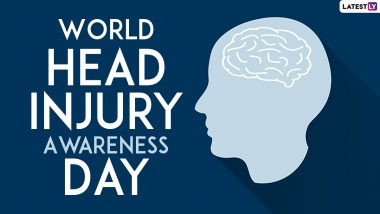Every year World Head Injury Awareness Day is observed on March 20 around the world. The day aims at spreading awareness about the number of people who suffer a head injury, right from a mild bump on their head to severe brain injury. It reminds us of how we could reduce accidents and brain injuries by being careful and the day also advocates the correct usage of safety gadgets such as helmets and seat belts to prevent damage to the head when one is involved in an accident. Let's discuss the World Head Injury Awareness Day 2021 date, history and significance and types of head injuries.
World Head Injury Awareness Day Date, History and Significance
March 20 sees the observance of World Head Injury Awareness Day annually. Every year, about 2 million people in the country report head injuries. Only a little carelessness causes half of these lives to end. If some reflex therapies are implemented, then the life of the victim can be saved in time. Brain or head injury can cause severe damage to the brain and skull. A head injury can lead to brain haemorrhage, fainting, and even death. The head, including the skull and face, provides protection to the brain. In addition to providing protection from bones, the brain is covered with hard fibrous layers and carries fluid around it.
Types of Head Injuries
Mild Traumatic Brain Injury (Concussion): This is also called brain trauma. This happens when there has been no loss of consciousness or it has been less than 30 minutes. Symptoms may appear at the time of injury or soon after, but sometimes they may not show until several days or weeks later.
Hematoma: A hematoma is a collection, or clotting, of blood outside the blood vessels. It can be very serious if a hematoma occurs in the brain. The clotting can lead to pressure building up inside your skull. This can cause you to lose consciousness or result in permanent brain damage.
Haemorrhage: A haemorrhage is uncontrolled bleeding. There can be bleeding in the space around your brain, called a subarachnoid haemorrhage, or bleeding within your brain tissue, called intracerebral haemorrhage.
Skull fracture: Unlike most bones in your body, your skull doesn’t have bone marrow. This makes the skull very strong and difficult to break. A broken skull is unable to absorb the impact of a blow, making it more likely that there’ll also be damage to your brain.
When there is an injury in the head, it is not necessary that the marks of that injury are visible on the skull. Despite no marks, brain functions can be damaged. The brain may be directly injured when a head injury occurs or it can have side effects on brain functions due to injury to the inner wall of the skull. There is a possibility of bleeding in the surrounding areas of the brain due to trauma to the brain.
(The above story first appeared on LatestLY on Mar 19, 2021 01:36 PM IST. For more news and updates on politics, world, sports, entertainment and lifestyle, log on to our website latestly.com).













 Quickly
Quickly




















